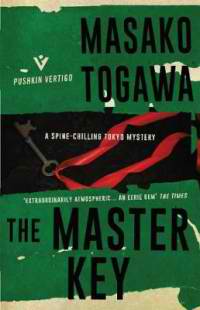The Lady Killer by Masako Togawa
 Wednesday, October 3, 2018 at 8:02AM
Wednesday, October 3, 2018 at 8:02AM 
First published in Japan in 1963; published in translation by Pushkin Vertigo on October 30, 2018
Pregnant from a one-night stand, Keiko Obana hangs from a windowsill until she plunges to her death. The police rule the death a suicide, but the inspector who investigates the case believes Keiko killed herself because of the pregnancy. So does a woman who believes her death is attributable to the rogue who made her pregnant.
After that prelude, the story follows Ichiro Honda (the rogue) as he seduces one woman after another, always assuming an identity other than his own, generally pretending to be foreign visitor to Japan. Honda keeps a diary of his sexual conquests that he refers to as his “Huntsman's Log.” The reader also follows Honda’s surprised response when he discovers that some of the women he seduced have been murdered. He even finds one of them dead when he turns up for a new assignation. Of course, the reader knows it is only a matter of time before Honda is blamed for the deaths.
The novel’s second half shifts the focus away from Honda to a young lawyer named Shinji who is helping an older lawyer handle Honda’s case. The older lawyer is the novel’s Sherlock, while Shinji does all the investigative legwork. Shinji is startled to learn that one of Honda’s conquests was a woman he was dating in college. Masako Togawa uses that coincidence to develop Shinji as a dispirited and lonely young man who is also a bit judgmental about Honda’s promiscuity — unless he is simply envious.
The Lady Killer creates a mystery for Shinji to unravel (how and by whom was Honda framed?) but it maintains interest by giving Shinji a series of interviews with characters who are carefully developed despite their brief appearances. Those characters — a medical intern, a salaryman, a salesman, a day laborer, and a gay prostitute — open a window on different aspects of Japanese life. The investigation also reveals how people are like “toothed cogs; once one cog slips out of sync, it damages not merely those around it but also others having no direct connection with it.”
The novel is noteworthy for its glimpse of Japanese culture, including the divide between older people who hold traditional values (for example, values that compel suicide for disloyalty) and younger people who have adopted a western approach to moral decision-making. Themes of duty and loyalty are prevalent throughout the novel. The Lady Killer also explores social norms, not unique to 1960s Japanese culture, regarding the judgment that society visits upon men who use women, even if the women happily agree to be used for a night of passion, and upon women who are branded as promiscuous because they enjoy casual sex.
At the same time, Honda’s view of himself as a hunter and of women as his prey makes it difficult to feel sympathy for Honda, even though he is an innocent accused. Yet Honda is far from being the most aberrant character in a story that exposes the dark side of humanity. This example of Japanese noir strives to spotlight darkness rather than to promote empathy for its characters.
The plot depends on an elaborate scheme to frame Honda for multiple murders that will expose him to the death penalty. My initial reaction was that the killer could more easily have killed Honda; the decision to kill several innocent people struck me as an unlikely way to seek revenge. By the end of the novel, however, a plot twist allows the reader to see the story in a different way. Combined with an epilog that fills in the gaps, the mystery’s resolution is credible, surprising, and satisfying.
RECOMMENDED
 TChris |
TChris |  Post a Comment |
Post a Comment |  Japan,
Japan,  Masako Togawa in
Masako Togawa in  Thriller
Thriller 